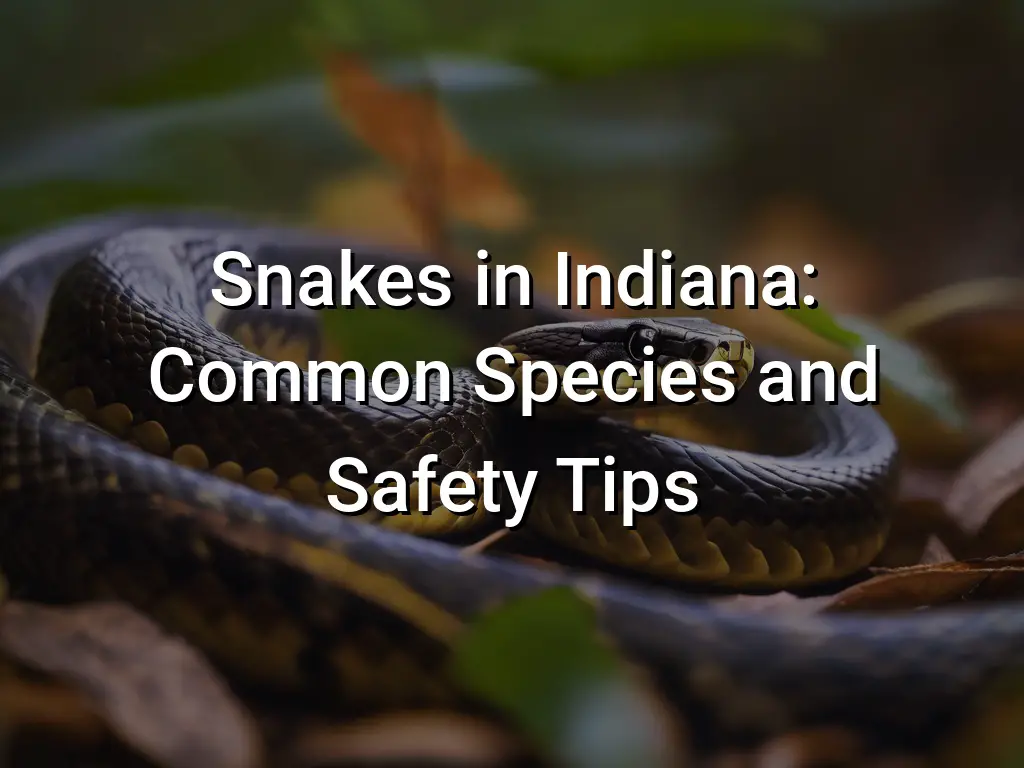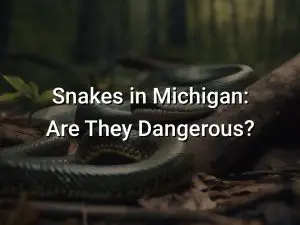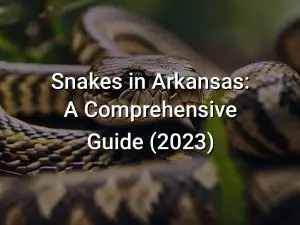Snakes in Indiana: Common Species and Safety Tips

Snakes may not be the most beloved creatures, but they are an important part of Indiana’s ecosystem. When exploring the great outdoors in Indiana, it’s important to be aware of the common snake species you may encounter and how to stay safe. Let’s take a closer look at some of the snakes you might find in the Hoosier State.
From the elusive Eastern Massasauga Rattlesnake to the harmless Eastern Garter Snake, Indiana is home to a diverse range of snake species. Learning about these snakes and understanding how to safely interact with them can help ensure a positive and safe outdoor experience for everyone. So whether you’re hiking through a forest or exploring a park, let’s dive into the world of snakes in Indiana.
Quick Links
Common Snakes in Indiana
Indiana is home to a variety of snake species, each with its own unique characteristics and habitat preferences. Here are some of the most common snakes that you may encounter in Indiana:
- Eastern Massasauga Rattlesnake: The Eastern Massasauga Rattlesnake is a venomous snake that is usually found in wetland areas. It has a distinct rattle on its tail that it uses as a warning sign.
- Eastern Copperhead: The Eastern Copperhead is another venomous snake in Indiana. It prefers wooded areas and is typically active during the day.
- Northern Water Snake: The Northern Water Snake is a non-venomous snake that is commonly found near water sources, such as lakes and rivers.
- Eastern Garter Snake: The Eastern Garter Snake is a non-venomous snake that is known for its distinctive yellow stripes. It is often found in gardens and grassy areas.
- Eastern Rat Snake: The Eastern Rat Snake is a non-venomous snake that is excellent at climbing. It can often be found in trees and buildings.
- Black Rat Snake: The Black Rat Snake is another non-venomous snake that is native to Indiana. It is often found in wooded areas and can grow up to 7 feet long.
- Smooth Earth Snake: The Smooth Earth Snake is a small non-venomous snake that is commonly found in forested areas, as well as fields and yards.
- Eastern Milk Snake: The Eastern Milk Snake is a non-venomous snake that is known for its vibrant colors and pattern. It is often found in woodlands and grasslands.
- Ringneck Snake: The Ringneck Snake is a non-venomous snake that gets its name from the yellow or orange ring around its neck. It is commonly found under rocks and logs.
Remember, while some of these snakes are venomous, most snake encounters in Indiana are harmless. It’s important to respect snakes and their habitats, and if you encounter a snake, it’s best to keep your distance and allow it to go on its way.
Eastern Massasauga Rattlesnake
The Eastern Massasauga Rattlesnake is a venomous snake native to Indiana. It is a small to medium-sized rattlesnake, typically measuring between 2 and 3 feet in length. The snake has a thick body and is typically brown or gray, with dark brown blotches running along its back. It gets its name from the segmented rattle on the end of its tail.
The Eastern Massasauga Rattlesnake can be found in wetland areas, such as marshes, swamps, and low-lying grasslands. It is a shy and reclusive snake that prefers to avoid contact with humans. It is most active during the warmer months and hibernates during the winter.
While the Eastern Massasauga Rattlesnake is venomous, it is not aggressive and will typically only bite if it feels threatened or cornered. Its venom is relatively mild compared to other rattlesnake species and is rarely life-threatening to humans. However, if bitten, it is important to seek medical attention immediately.
To stay safe in areas where the Eastern Massasauga Rattlesnake may be present, it is important to be aware of your surroundings and take precautions. Avoid reaching into tall grasses or under rocks and logs without first checking for snakes. If you encounter a snake, give it plenty of space and do not attempt to handle or capture it. Instead, slowly back away and leave the area.
If you do come across an Eastern Massasauga Rattlesnake in your yard or near your home, it is best to contact a professional snake removal service to safely remove the snake. It is important not to attempt to capture or kill the snake yourself, as this can be dangerous and may also be illegal.
Eastern Copperhead
The Eastern Copperhead is a venomous snake found in Indiana. They are easily identified by their distinctive copper-colored head and hourglass-shaped markings on their body. They typically grow to be around 2-3 feet long and prefer to inhabit rocky, wooded areas.
While the Eastern Copperhead is venomous, they are generally not aggressive and will only bite if threatened or provoked. Their venom is potent and can cause significant pain and swelling, so it is important to exercise caution when encountering them in the wild.
If you come across an Eastern Copperhead, it is best to keep your distance and give the snake plenty of space to retreat. Avoid approaching or attempting to handle the snake, as this can increase the likelihood of a bite. Keep in mind that snakes play an important role in the ecosystem and should be respected from a distance.
When hiking or spending time in areas where snakes may be present, it is advisable to wear appropriate footwear and clothing to minimize the risk of being bitten. Avoid placing your hands or feet in areas where you cannot see, such as tall grass or under rocks.
If you are bitten by an Eastern Copperhead or any other venomous snake, seek immediate medical attention. Do not attempt to suck out the venom or apply a tourniquet, as these methods are ineffective and can cause further harm.
Remember, with proper awareness and precautions, you can safely coexist with snakes in Indiana’s natural habitats.
Northern Water Snake
The Northern Water Snake, also known as Nerodia sipedon, is a common species of snake found in Indiana. As its name suggests, this snake is primarily found in or near water habitats such as lakes, ponds, rivers, and wetlands.
The Northern Water Snake can vary in appearance, but it typically has a dark brown or black color with lighter-colored bands or blotches along its body. It has a thick body and a round head, and it can grow to be about 2 to 4 feet in length.
Despite its intimidating appearance, the Northern Water Snake is non-venomous and generally harmless to humans. It is, however, known to be an aggressive species and will bite if it feels threatened or cornered. Its bite can be painful and may cause minor bleeding, so it’s important to give these snakes their space and avoid handling them.
The diet of the Northern Water Snake consists mainly of small fish, amphibians, and invertebrates, which it catches by swimming and subduing its prey underwater. These snakes are strong swimmers and are often seen basking on rocks or logs near the water’s edge.
If you encounter a Northern Water Snake in the wild, it’s best to observe it from a safe distance and appreciate its role in balancing the ecosystem. Remember, snakes play an important role in controlling rodent populations and maintaining the overall health of their habitats.
When it comes to safety around snakes, it’s important to exercise caution and respect their space. If you encounter a snake while hiking or spending time outdoors, give it plenty of room to escape and retreat. Keep a safe distance and avoid approaching or handling the snake.
It’s also a good idea to familiarize yourself with the common snake species in your area, like the Northern Water Snake, to better understand their behaviors and potential risks. By being informed and prepared, you can coexist with these fascinating creatures and appreciate the diverse wildlife in Indiana.
Eastern Garter Snake
The Eastern Garter Snake is one of the most common snake species found in Indiana. It is a non-venomous snake with a long, slender body and distinctive markings. The snake typically has a green or brown color with three yellow stripes running down its body.
Garter snakes are known for their adaptability and can be found in various habitats, including grasslands, forests, wetlands, and urban areas. They are active during the day and are often seen basking in the sun or searching for prey.
Eastern Garter Snakes mainly feed on small mammals, amphibians, and insects. They play an important role in controlling populations of rodents and pests. Despite their name, they are not just restricted to garters, but also eat a variety of other prey.
These snakes are generally harmless to humans and prefer to avoid confrontation. If threatened, they may release a foul-smelling musk as a defense mechanism. However, they rarely bite and their bites are usually harmless. If you encounter a garter snake, it’s best to leave it alone and appreciate it from a distance.
It’s important to remember that all snakes, including non-venomous species like the Eastern Garter Snake, should be treated with respect and caution. If you come across a snake and are unsure of its species or behavior, it’s best to keep your distance and contact a local wildlife or snake expert for assistance.
Eastern Rat Snake
The Eastern Rat Snake, also known as the Black Rat Snake, is one of the most common snake species found in Indiana. It is a non-venomous snake that can grow up to 6 feet in length. This snake is known for its shiny black color, although it may also have some gray or brown markings.
The Eastern Rat Snake is often found in wooded areas, fields, and around buildings. It is an excellent climber and can often be seen in trees or on fences. This snake is an important part of the ecosystem as it helps control rodent populations.
Despite its intimidating size, the Eastern Rat Snake is not aggressive and will usually try to escape when encountered by humans. It is known to be docile and can be easily handled. However, it can become defensive and may bite if it feels threatened or cornered. If you come across an Eastern Rat Snake, it is best to keep a safe distance and observe it from afar.
It is important to remember that all snakes play a crucial role in the environment and should be respected. If you have concerns about snakes in your area, it is best to contact a local wildlife agency or snake expert for guidance. They can provide information on how to safely coexist with these reptiles and prevent any potential conflicts.
Black Rat Snake
The Black Rat Snake (Pantherophis obsoletus) is a non-venomous snake commonly found in Indiana. It is one of the largest snake species in the state, capable of reaching lengths of up to 8 feet. The Black Rat Snake is known for its shiny black body with a white or yellow underside, as well as its smooth scales.
This species is predominantly found in wooded areas, such as forests and fields near water sources. It is an excellent climber and can often be seen in trees or on fence posts. The Black Rat Snake is primarily active during the day and is known to be a good swimmer.
Black Rat Snakes primarily feed on small mammals, including rats, mice, and squirrels. They are also known to consume birds and their eggs. As non-venomous snakes, Black Rat Snakes subdue their prey by constricting it, squeezing tighter with each breath until the prey suffocates.
When threatened, the Black Rat Snake will try to escape or remain motionless to blend in with its surroundings. If cornered, it may hiss, coil, and strike as a defensive response. However, it is important to note that Black Rat Snakes are not aggressive towards humans and will typically only bite as a last resort if they feel threatened or provoked.
Black Rat Snakes play an essential role in controlling rodent populations, making them beneficial to ecosystems and humans alike. If you encounter a Black Rat Snake in the wild, it is best to observe from a safe distance and allow it to continue with its natural behavior.
Remember, if you are unsure about the species of snake you have encountered or feel uncomfortable handling it, it is always best to contact a professional snake removal service to ensure your safety and the snake’s well-being.
Smooth Earth Snake
The Smooth Earth Snake is a small, non-venomous snake commonly found in Indiana. It is typically brown or grayish-brown in color with smooth scales, giving it its name. The average length of a Smooth Earth Snake is between 6 to 10 inches.
Smooth Earth Snakes are burrowing snakes and are often found in moist habitats such as woodlands, marshes, and gardens. They are known to burrow in loose soil or leaf litter, making it easy for them to blend in with their surroundings.
These snakes primarily eat earthworms and small invertebrates. They capture their prey by seizing them with their teeth and swallowing them whole. As they are nocturnal, they are most active during the night when their prey is more abundant.
Smooth Earth Snakes are relatively harmless and docile. They have very small teeth and are not known to bite unless they feel threatened or provoked. If encountered, it is best to simply observe them from a distance and leave them be.
As natural predators of small invertebrates, Smooth Earth Snakes play an important role in maintaining ecological balance. While they may not be as commonly seen as other snake species, knowing about their presence and appreciating their place in the ecosystem can help foster coexistence and understanding.
Eastern Milk Snake
The Eastern Milk Snake, scientific name Lampropeltis triangulum, is a non-venomous snake species that is commonly found in Indiana. It is known for its vibrant colors and distinctive banding pattern, which often resemble those of the venomous Eastern Coral Snake. However, the Eastern Milk Snake can be distinguished by its red or orange blotches, while the Eastern Coral Snake has yellow blotches.
Eastern Milk Snakes are typically found in a variety of habitats, including grasslands, forests, and agricultural areas. They are active mainly at night and feed on small mammals, birds, reptiles, and amphibians. As they are constrictors, they subdue their prey by coiling around and suffocating them before consuming them whole.
These snakes play an important role in controlling rodent populations, making them beneficial to the ecosystem. They are generally docile and non-aggressive towards humans but may bite if threatened or handled improperly. However, their bite is harmless and rarely causes any significant harm.
If you encounter an Eastern Milk Snake in Indiana, it is best to observe it from a distance and not attempt to handle or disturb it. Remember that these snakes are protected species in the state, so it is illegal to harm or kill them.
To ensure your safety and the snake’s well-being, it is essential to learn how to distinguish between venomous and non-venomous snakes in Indiana. By knowing the common species and their characteristics, you can better appreciate and coexist with these fascinating reptiles.
Ringneck Snake
The Ringneck Snake is a small and slender snake commonly found in Indiana. It gets its name from the bright yellow or orange ring on its neck, which contrasts against its dark-colored body. Ringneck Snakes are non-venomous and relatively harmless to humans.
These snakes are mostly active at night and prefer to hide in damp areas such as rotting logs, leaf litter, or under rocks. They feed on small invertebrates like worms, slugs, and insects.
If you come across a Ringneck Snake, it is best to admire it from a distance. They are generally shy and will try to escape if they feel threatened. Like most snakes, they may bite if they are handled or provoke severely, but their small size makes their bites harmless to humans.
Ringneck Snakes are beneficial to the ecosystem as they help control populations of pests such as slugs and insects. So, if you encounter one in your yard or garden, consider letting it be and appreciating its role in maintaining the balance of nature.
Conclusion
Now that you are familiar with some of the common snake species in Indiana and have learned some safety tips, you can feel more confident when encountering snakes in the area. Remember, most snakes you encounter are harmless and play an important role in the ecosystem.
If you ever come across a snake, it’s best to keep a safe distance, observe it from afar, and avoid any sudden movements. By respecting snakes and their habitats, you can coexist peacefully with these fascinating creatures in the great outdoors.







